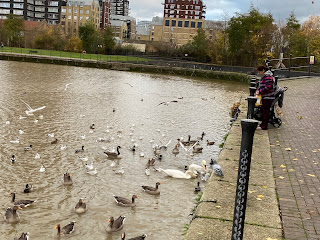To East London last week where, on a cold but clear day, I wanted to visit a nature reserve that used to be part of a dock. The East India Docks, specifically — built in Blackwall in 1803 for the East India Company, and closed in 1967 (the first of London’s docks to close as the shipping industry moved towards containerisation which ultimately saw everything move downstream to Tilbury). As part of the redevelopment of the Docklands, the East India Docks were filled in and built upon (the East India DLR station opened in 1994), but the entrance basin remained — and became one of London’s smallest nature reserves.
Located just to the north of the Thames (from which it’s separated by a lock gate) as it loops around the Greenwich Peninsular, it has a saltwater (well, brackish water) lagoon, a reedbed and a small copse.
In the spring and summer, it’s a nesting site for Common Terns and is home to the elusive Black Redstart (a bird I’ve only ever seen in Italy). In the colder months, it’s a major site for wintering ducks.
On one of my days off, I decided to make a day of it. As well as visiting the dock basin for the first time in several months, I also took the opportunity to explore a Wren church in the City. I duly got the Tube down to Bank and picked one st random that I had not been in before — St Mary Abchurch with its interior dome and superb wood carvings; a real gem. Then back into Bank station to take the DLR east.
Before entering the dock basin itself I walked down to the River from the DLR station, along the Meridian Line no less (it’s makes out on the pavement). There were many Black-headed Gulls on the water, accompanied by a lone Cormorant, a few Herring Gulls and — perhaps inevitably— some Feral Pigeons flying overhead. A passer-by asked me about birdwatching, claiming to have never come across one before even though she lives nearby and walks through the basin regularly (for non-birding locals, it’s a great haven from the bustle of urban London, much like that church is a superb place in which to escape the busy-ness of the City for a while).
In the basin itself, there was a fair mix of waterfowl. Three species of geese — Greylag, Canada and Egyptian — plus one Greylag-Canada hybrid. A pair of Mute Swans, three Shelduck, thirteen Mallards, fifteen Teals and a single (male) Tufted Duck.





No comments:
Post a Comment